|
Our
film opens, serenely enough, with a scenic
tour of our titular bay (--
that isn't very bloody ... yet.)
Our tour then continues through several
dilapidated buildings until we come to the
main house, that of Countess Donati (Isa
Miranda). The mansion, itself, is
in pretty good shape, but as the old girl
makes her way through it, by way of her
wheelchair, you get an overwhelming sense
of melancholy from her as she moves from
empty room to empty room, object to
object. And her
mood isn't going to get any better,
either, as she enters another room and
spies a noose hanging in the doorway!
Then, as the noose is thrown around her
neck, the unseen assailant then kicks the
wheelchair out from under her and the
Countess falls and strangles under her own
weight.
With
the dastardly deed done, the camera pans
to the killer's feet before panning up to
reveal the customary black leather gloves
that all killers in these Italian gialli
are required to wear. But then the movie
throws us the first of many curveballs as
it keeps on panning up, revealing the
killer's face (-- What? Already?).
The revealed killer is the Count Donati (Giovanni
Nivolletti), the Countess' much
younger, gold-digging husband, who
moves to her desk and drops a note on it;
the note is in Italian, but considering
her earlier mood, it's not too hard to
decipher that this will serve as a [fake]
suicide note. So, the Count,
for some reason yet to be revealed, has
murdered his wife and is making it look
like a suicide. Will he get away with it?
Well,
the answer to that is an abrupt and brutal
"No!" as another killer lunges
out of the darkness and stabs the Count,
repeatedly, with a knife. So, who killed
the Count?
And why did the Count
kill his wife? We don't know, yet; but
eleven more people will meet their
gruesome demise for those vary reasons
before the end credits roll...
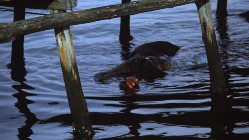
Mario
Bava, a movie icon if there ever was one,
broke into the movie business as a
visual-effects artist, cinematographer,
and production designer. And if not for
several instances of directors quitting on
projects he was assigned to, where he was
pressed into service to finish them -- and
in some cases, these directors would quit
on purpose just to get the reluctant and
reclusive Bava into the director's chair
-- the world might have been denied his
amazing -- nay, brilliant talents.
Over
the years, like most of his Italian
contemporaries, Bava had a hand in all
kinds of genres; off the wall spy-flicks [Diabolik];
westerns [Roy
Colt and Winchester Jack];
crime dramas [Rabid
Dogs];
sword and sandal [Hercules,
Hercules
Unchained
and
the fantastic Hercules
in the Haunted World];
Teutonic Viking epics [Knives
of the Avenger];
science fiction [Planet
of the Vampires]
-- hell, he even made a giant monster
movie once [Caltiki:
The Immortal Monster
-- Italy's
only giant monster movie I might add --
unless you count Tentacles,
but why would you want to?].
Studios and producers loved him for his
fast shooting pace, and his ability to
camouflage and maximize their miniscule
budgets with his camera tricks and Bava's
uncanny knack for making every pinched
penny shown on screen look like a $1000.
With all that success Bava's only real
failure was at comedy, where he bombed and
bottomed out with Dr.
Goldfoot and the Bikini Bombs.
This
misfire cost him a contract with American
International,
meaning no more American distribution
until this film, and one wonders if this
disaster was by design to free him up to
do other things? I doubt it. As it would
be almost two years before Bava would
direct again.
Now,
Bava might be best remembered on this side
of the Atlantic for those gothic horror
shows that AIP imported -- and drastically
toned down, with the likes of Black
Sunday
and Black
Sabbath
(--
that a lot of folks wrongfully assume are
the same film; the first one is with
Barbara Steele, and the second featured
Boris Karloff in one of his last film
roles --); that
is, he would be best remembered for
them if it weren't for this
particular film we're reviewing today. Before
Bikini Bombs tanked, Bava was
putting his own personal stamp on a new
genre that would come to be known as the gialli;
violent whodunits that were short on
mystery but long on the body counts, with
very lurid titles that would fit perfectly
on the cover of the pulp novels and 'zines
that inspired them. Historically,
in cinema, murder was usually a crime of
heated passion, cold revenge, or an act of
greed, but a new source was edging its way
in -- usually of a repressed sexual or
psychological dysfunction,
meaning motives were no longer relevant,
and, more importantly, everyone's a
suspect. They seldom made a lot of sense
until -- like in any old Agatha Christie
novel, where what few clues you were given
don't make any sense and prove basically
irrelevant -- the twelfth hour revelation
links it all together and explains
things, for the most part, satisfactorily.
(Usually reserved for the last
chapter or reel to make sure you'll stick
around for the whole thing.) So,
with most gialli, patience is a
virtue -- that can often be stretched past
the point of critical credulity!
For
more on this phenomenon, check out my
review of Guilio Questi's Death
Laid an Egg.
Though
the seeds of Bava's visual and
dinstinctive style were planted in The
Girl Who Knew Too Much
they didn't reach full bloom until Blood
and Black Lace
-- upon whose viewing this particular
critic had the first realization that he
was watching cinema, not just a movie.
His new breed of continental thrillers
were both visually stunning and
financially successful, which, of course,
bred a rash of imitators. However, Bava
continued to make them, and make them
better, but after Five
Dolls for an August Moon
he was growing tired of the formula, and
his own hype, and was ready to try
something different. Or maybe, just maybe,
he wanted to show all those young Turks
like Argento, Lenzi and Martino that the
Old Man was still the king.
A
Bay
of Blood
began
as an idea co-conspired by Bava and
actress Laura Betti while making Hatchet
for a Honeymoon.
Securing limited financing from producer
Giuseppe Zaccariello, the script went
through several stages and four
collaborators before the cameras rolled;
which is amazing as it seems that Bava's
only real desire, here, is to focus on the
murders themselves. For, the plot that
strings them together is totally
convoluted, extremely confusing, and makes
Raymond Chandler's The
Big Sleep
read like shampoo instructions.
Don't
believe me? Read on...
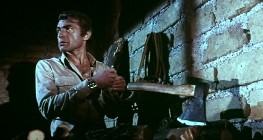
Now
we, as the audience, know Count Donati has
been murdered but his body has
mysteriously disappeared. (However,
that mysterious splashing we heard during
those scenic shots of the bay gives us a
pretty good clue where he is.)
Meanwhile, when the other body is
discovered, the police find the note and
are satisfied that the Countess committed
suicide. And the fact that the Count is
nowhere to be found only reinforces these
assumptions. Seems the Count liked to cat
around and, figuring he has run off again
with some floozy -- like so many times
before -- the authorities conclude that
the cumulative effect of these dalliances
finally pushed his estranged wife over the
edge. But that wasn't the only
cantankerous point of contention between
them. Apparently, the Count wanted to
develop the prime piece of real estate
around the bay into a tourist resort. But
after an abortive first effort, the
Countess pulled the plug and was content
to keep the bay unmolested by outside
forces. (This failed effort
explains all the abandoned buildings
around the mansion.) We learn most
of this via some handy plot exposition
provided by the Fosattis, Paola (Leopoldo
Triesta) and Anna (Betti),
who rent one of the cabins, and Simon (Claudio
Volante), the groundskeeper, who
lives in a shack down by the docks (--
and has a thing for munching on raw
octopus.) The
twitchy Paola is an entomologist who
spends his days collecting insects and
sticking needles in them. He's glad that
the Countess decided against changing
things, keeping it all natural for him and
his creepy-crawlies, but worries what will
happen now that she's dead. Simon,
who is one surly S.O.B., isn't sure if it
was a suicide at all and believes the
Count might have killed her and run off,
then continues to chew on his octopus.
Anna, meanwhile, is mostly concerned with
her next drink and spends most of her time
reading her tarot cards, forecasting doom
and damnation, and listening in on
conversations that really don't concern
her. Through her gift of gab and gossip,
though, she also knows who Simon really
is. And if you were paying attention
earlier, so will you.
Anyways,
the plot then thickens some more with the
entrance of two more players: Frank
Ventura (Cristea
Avram), who is either some kind of
lawyer or a real estate agent, and Laura (Anna
Rosati), his girlfriend/secretary,
who are just finishing up with the
horizontal bop. After they dress, Ventura
talks about heading to the bay to secure
an all important signature as part of his
master plan. Whose signature does he need?
We don't know, and he's not saying. And
fair warning: the movie is only beginning
to be coy with us. Wanting to go with him,
Laura is told to stay put and promised it
shouldn't take long ... Meanwhile, the
Donati estate receives a few more
visitors, when Reneta (Claudia
Auger) and Albert (Luigi
Pistili), and their two young
children, arrive in an RV. Seems Reneta is
the Count's daughter from a previous
marriage, and, suspicious of his sudden
disappearance, they've come to try and
find him. Thusly, after putting the
children to bed, they venture out into the
gloom to see if they can find any clues to
his whereabouts. Then, things get even
more crowded, and
the plot starts to curdle a little, when
two local teenagers, Duke and Robert (Guido
Boccaccini and Roberto Bannani),
decide to take their new girlfriends,
Brunhillda and Denise (Brigitte
Skay and Paola Rubens), to the
scenic bay, figuring the old abandoned
resort will be a great spot to score a
little nookie. (Yeah, you're right.
They're not going to last very long.) Oh,
and before I forget, Laura decides to come
anyway, on her own, making it an even "Ten
Little Indians"
for our mad killer to dispose of. And
after all of these potential victims are
drawn into the web of murder, greed and
family intrigue, after a slow and
confusing build-up,
the killings comes fast and furious!
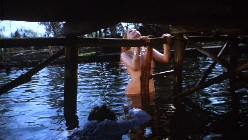
At
first, we're not sure who the killer is;
but as the evening progresses, and the
bodies start piling up, it's revealed that
a deadly conspiracy is behind it all to
take control of the Donati estate and cash
in on the land. But, for the record, there
is more than one killer running amok, as
there are two separate factions
killing for the land, eliminating heirs
and witnesses. And
just like in Chandler's aforementioned
novel, we're still not sure who killed who
in some instances. But it
is kind of neat how the whole thing
unravels and plays out. I hesitate to
spoil it, so I'll give you this option:
With a helpful assist from the Parker
Brothers, you can click on the link below
to see who got killed, how, and whodunit.
If you don't want to know, just skip it
and read on. However, there are still a
few spoilers ahead in the text but they
shouldn't ruin the experience for you.
Choose wisely.
The
Bay of Blood Index O' Death
Welcome
back.
Are
you still with me? Good.
So,
in the end, everybody's dead.
"That's
not a spoiler?!" you cry
incredulously.
No,
not really. Like
I said earlier, I like the way the ending
unravels, how the conspiracy is revealed,
and the film's first two climaxes. The
third climax, however, when the movie
should have been over but the killers are
mysteriously killed is, forgive me Mr.
Bava, monumentally silly -- and verging on
stupid. There's a ton of evidence that all
the carnage we've just witnessed is one
long, and morbid joke; the kamikaze fly
who bites it in the drink; cutaways to
"smiling" cars; and victims
finishing off an orgasm before they expire
... You just get the sense that the
director is winking at you the whole time.
True, the eccentric Bava had a wickedly
perverse sense of humor, and I'm sure it
was amusing at the time, but after that
much of an audience investment it comes
off a little too trite for me -- like a
joke or running gag that has overstayed
it's welcome and moved beyond droll, and
is barreling toward full-blown annoyance.
I
think most of my frustrations, aside from
that ending, with A
Bay of Blood
can be
blamed on the atrocious audio track on
Image Entertainment's DVD; sold as Twitch
of the Death Nerve
-- part of the Mario Bava Collection.
In
this instance the
plot is muddled and hard to follow because
the plot is hard to hear. The mix is out
of whack, and it's hard enough to keep
track of what's going on without the
dialogue being drowned out by the ambient
soundtrack.
I spent half the movie under the wrong
assumption that all the characters were
related, making them heirs to be
eliminated, but it turns out most of them
weren't; just
in the wrong place at the wrong time, or
witnesses that need to be eliminated.
I
think a lot of this could be cleared up
with either a re-dub or, better still, use
the original Italian track and just give
me some subtitles. (Honestly, I
don't mind reading while watching.)
Is anything like this available? Are there
any better versions out there? My search
came up bupkus.
Update:
Our prayers have been answered with a
remastered soundtrack in the version
available in Anchor Bay's Mario Bava Box
set.
However,
as I said before, the plot of who covets
the bay the most is a convenience, or
contrivance, to just string the murders
together making the point moot. But are
these thirteen murders enough to carry the
film, then? Yeah, they are. They may seem
routine today but you've got to have some
perspective, here, as this one came first.
Making a conscious decision to not turn
away when the killer catches up to his/her
victim, Bava lets the camera's eye, and
the audience, linger until the violence is
done. If you've ever wondered what a Sam
Peckinpah horror movie would look like?
Here you go. Some
of the deaths are shocking, like Robert's
machete facial; others are oddly comical,
like when the coupling couple are pinned
together with the spear and apparently
reach orgasm before they both expire;
while others, like Simon's death, are an
odd combination of both; and if you've
seen the film, you'll know what I'm
talking about.
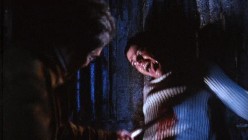
Almost
40 years later Carlos Rambaldi's
gore-effects hold up remarkably well. And
though Rambaldi went on to do the special
make-up effects for Andy
Warhol's Frankenstein
and Dracula,
and built the aliens for Alien
and E.T.,
he will always be remembered, by me
anyways, for his colossal failure to
deliver the promised robotic goods in Big
Dino D's remake of King Kong.
But he's on top of his game, here. And I
especially like the scene when the killer
pulls the cleaver back out of Robert's
face -- and Robert is still alive and
blinking!!!
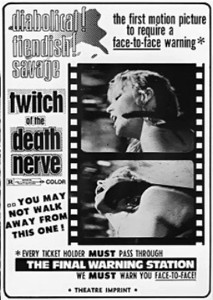 Despite
the shoestring budget and no-frills shoot,
Bava was proud of the finished film. But
his voyeuristic and grisly approach was so
vastly different than his established
style the film was a critical disaster.
The domestic box office gross, however,
went through the roof ... It
was Steve Minasian and his Boston based
Hallmark Releasing that imported Reazione
a catera (--
translated it means "chain
reaction"),
as it was known in Italy,
to the States. Renaming it Carnage,
Minasian
ballyhooed it with an all day free preview
and lured them in with a full page
newspaper ad that warned the film was "The
real thing -- the first movie that dares
to show hardcore violence." HRC
even slapped a self-imposed rating of
"V -- for Violence" to really
get everyone's attention, and teased the
potential audience more by insisting each
ticket holder be required to receive a
face to face warning about what they were
about to experience before being admitted
into the theater. This type of promotion
had worked well before on the earlier
imported Mark of the Devil,
so Minasian did it again, bringing the
[morbidly] curious public in in droves.
But the film ran into some legal hassles
with the MPAA over the fake rating and was
quickly withdrawn -- only to be reborn
again, under a different title and ad
campaign as Twitch of the Death
Nerve. The lurid title, the delivered
goods, and positive word of mouth made it
a drive-in hit. A hit so big that Hallmark
kept it in circulation, and kept squeezing
dollars out of it, by changing the title
a whopping twelve times before it made its
last tour as Last House
on the Left II
in 1977. Despite
the shoestring budget and no-frills shoot,
Bava was proud of the finished film. But
his voyeuristic and grisly approach was so
vastly different than his established
style the film was a critical disaster.
The domestic box office gross, however,
went through the roof ... It
was Steve Minasian and his Boston based
Hallmark Releasing that imported Reazione
a catera (--
translated it means "chain
reaction"),
as it was known in Italy,
to the States. Renaming it Carnage,
Minasian
ballyhooed it with an all day free preview
and lured them in with a full page
newspaper ad that warned the film was "The
real thing -- the first movie that dares
to show hardcore violence." HRC
even slapped a self-imposed rating of
"V -- for Violence" to really
get everyone's attention, and teased the
potential audience more by insisting each
ticket holder be required to receive a
face to face warning about what they were
about to experience before being admitted
into the theater. This type of promotion
had worked well before on the earlier
imported Mark of the Devil,
so Minasian did it again, bringing the
[morbidly] curious public in in droves.
But the film ran into some legal hassles
with the MPAA over the fake rating and was
quickly withdrawn -- only to be reborn
again, under a different title and ad
campaign as Twitch of the Death
Nerve. The lurid title, the delivered
goods, and positive word of mouth made it
a drive-in hit. A hit so big that Hallmark
kept it in circulation, and kept squeezing
dollars out of it, by changing the title
a whopping twelve times before it made its
last tour as Last House
on the Left II
in 1977.
Minasian
still wasn't done bilking Reazione
a catera,
though. You see, HRC was also in the
business of financing a few domestic
pictures of its own. One in particular was
a film by a couple of unknowns by the name
of Wes Craven and Sean S. Cunningham.
Their picture, obviously, was the original
Last
House on the Left,
and Minasian would back Cunningham's next
project, A Long Night at Camp Blood,
too. But you probably know that one better
as Friday
the 13th.
To say Cunningham borrowed some ideas from
Bava's film is an insult, but this kind of
thing has been going on since filmmaking
began; there's a fine line between paying
homage and ripping off and, frankly, I've
as yet to determine the difference -- so I
usually try to let this kind of stuff
slide. Carpenter's Halloween
started
the blood flowing, so to speak, but it
wasn't until after Friday
the 13th
that
this type of slasher film became a full
blown epidemic. Spawning hundreds of its
own imitators, the horror film, as a
genre, has been hemorrhaging out (--
to keep the blood references coming --)
and suffering the consequences ever since.
Don't get me wrong; I love these types of
movies, but for a span of about fifteen
years that's the only kind of
horror movie that got made. And even after
that, the genre was still having problems
recovering from their hangover and
couldn't seem to establish any kind of
identity beyond them.
Gialli,
Canuxploitation -- Canada produce a ton of
these things in the early '80s, and
probably the ones you remember most like Prom
Night or My Bloody Valentine
-- stalk and slash, slasher, or body count
movies, call them what you will, didn't
involve a lot of original thinking. There
were rules and standards and practices
that were followed to achieve the
producer's goal. And, no. Not some
artistic statement -- profits. Even
the Weinstein's built their Miramax empire
with the humble beginnings of The
Burning.
I'm sure at the time of its production
Bava had no clue that A
Bay of Blood
would set the template for such things,
but set them it did. Here are a few scenes
and traits that soon became standard:
Slasher
101.
-
All
is well. No worries. Arrrgghh! ...
There are a lot of misleading
musical cues to the lull the
audience into a false sense of
security; and then, whammo!, someone
gets skewered by something sharp.
-
Watch
out for the local kooks, spooks, and
red herrings. And ignore their
warnings or prophecies of doom ... There's
usually some local weirdoes or
perverts hanging around. The twitchy
Paolo Fosatti and his penchant for
skewering bugs has red herring
written all over him. And while his
wife tries to warn everyone that
death is lurking about, no one
listens. She doesn't listen, either,
and fails to make it to the end.
-
Cannon
fodder ... Don't have enough
people in your cast to have a big
enough body count? No problem. Just
have a group of unlikable teens that
are irrelevant to your
"plot" wander onto your
set on the wrong day and at the
wrong time and they'll never know
what hit them.
-
Culling
the herd. Stalk before the slash ...
One at
a time, people. Divide and conquer.
Separate, then slaughter. Remember:
you don't have to do anything, as
your victims will usually do it for
you. String it out as long as you
can, too. And can you keep losing
your top and tripping while trying
to run away from me? Thanks. Let's
see. Nothing around this corner.
Nothing around that corner. There's
probably nothing around here either
... *thwack*.
-
Get
naked and die ...
Or have sex and die. Wander
off by yourself and die. Be greedy
and die. Wear the wrong color of
socks and die.
-
The
Bloody Money Shot... It
pays to have a good F/X team on your
project. Since your plot stinks, and
your characters are cardboard
cutouts, this is your bread and
butter and the reason why people
come to see the movie -- so you'd
best make it count. Each film has
multiple murders, but there is
always one or two spectacularly
gruesome sequences that everyone
will still be talking about come
tomorrow. Whether somebody gets
their head lopped off, complete with
a fountain of blood coming out of
the stump, or someone taking a
meat-cleaver to the face, the gorier
the merrier.
-
The
body pile ...
How they get them moved so fast is
beyond me. And how they hide the
smell is an even bigger mystery, but
pray you don't find it -- unless
you're the final girl -- or you'll
soon be on top of it.
-
I'm
not quite dead ... Characters
that you think are dead keep popping
back up. This super-power would
eventually transfer to the killer,
or be bestowed upon a character the
audience likes who would
miraculously recover from mortal
wounds after the climax (Think
Deputy Dewey in Scream.)
-
Motive?
We don't need no stinkin' motive ...
I've touched on this already: all
you need is the barest of threads to
string the murders together as it
became less and less about whodunit
but how they "dunit", how
many they "dunit" to, and
with what sharp object they
"dunit" with.
-
The
twist in the plot -- or -- "Oh,
it's just you ... Wait. You! You're
the killer"... Here
we have the origin of the final
girl. Yes, I know, Laura doesn't
make it but her confrontation with
Simon in the cabin is stolen, almost
verbatim, for Friday the
13th
when Alice realizes that Mrs.
Voorhees isn't quite right in the
head. Hell, she and Simon are even
wearing almost the exact same
sweaters! This of course leads to...
-
Yes,
I did it -- and now I'm going to
tell you why ... Once Simon goes
all schizo on Laura and spews venom
at her, fingering her as one of his
mother's murderers, we know we'll be
seeing a lot of family skeletons
coming out of the closet and
psychoses spewed forth to try and
rationalize and justify all the
carnage we've just witnessed over
the last hour and half for years to
come.
-
Oh,
and one more thing before you go ...
Ah, the shock ending out
of left field. Affectionately known
as the cheese-dick ending around
these parts. This would eventually
morph into the killer isn't really
dead, to rise one more time for a
scare, or he's still on the loose
when the credits roll --
because we need 'em for the sequel.
Thirty
years after the fact, Bava's initial
vision has been so distilled and watered
down that they've become laughable clichés.
Sure, they may have copied his murders and
his formula, but they can't touch his
distinctive style. Hands down, this guy is
my favorite director of all time. His
films are not meant to be watched, but experienced.
(And
even his colossal misfires are beautiful
to look at.) And I'll argue with
anyone that nobody has had a bigger
influence on horror films than this guy. I
think he saved the genre once with Black
Sunday,
but also, regrettably, and it's not really
his fault, he went on to devastate the
genre, as a whole, no matter how much you
enjoy them, like I do (--
and I can't stress that enough),
with A Bay of Blood and its bastard
progeny.
|